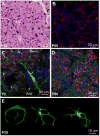Myoepithelial Cells: Their Origin and Function in Lacrimal Gland Morphogenesis, Homeostasis, and Repair
- PMID: 26688786
- PMCID: PMC4683023
- DOI: 10.1007/s40610-015-0020-4
Myoepithelial Cells: Their Origin and Function in Lacrimal Gland Morphogenesis, Homeostasis, and Repair
Abstract
Lacrimal gland (LG) is an exocrine tubuloacinar gland that secretes the aqueous layer of the tear film. LG epithelium is composed of ductal, acinar, and myoepithelial cells (MECs) bordering the basal lamina and separating the epithelial layer from the extracellular matrix. Mature MECs have contractile ability and morphologically resemble smooth muscle cells; however, they exhibit features typical for epithelial cells, such as the presence of specific cytokeratin filaments. Increasing evidence supports the assertion that myoepithelial cells (MECs) play key roles in the lacrimal gland development, homeostasis, and stabilizing the normal structure and polarity of LG secretory acini. MECs take part in the formation of extracellular matrix gland and participate in signal exchange between epithelium and stroma. MECs have a high level of plasticity and are able to differentiate into several cell lineages. Here, we provide a review on some of the MEC characteristics and their role in LG morphogenesis, maintenance, and repair.
Keywords: Branching; Epithelium; Fibroblast growth factor; Lacrimal gland; Mesenchyme; Morphogenesis; Myoepithelial cells; Progenitor cells; Regeneration; Smooth muscle actin; Stem.
Conflict of interest statement
Figures



References
-
- Faraldo MM, Teuliere J, Deugnier MA, Taddei-De La Hosseraye I, Thiery JP, Glukhova MA. Myoepithelial cells in the control of mammary development and tumorigenesis: data from genetically modified mice. J Mammary Gland Biol Neoplasia. 2005;10:211–9. - PubMed
-
- Avci A, Gunhan O, Cakalagaoglu F, Gunal A, Celasun B. The cell with a thousand faces: detection of myoepithelial cells and their contributions in the cytological diagnosis of salivary gland tumors. Diagn Cytopathol. 2012;40:220–7. - PubMed
-
- Abe J, Sugita A, Hamasaki M, et al. Scanning electron microscopic observations of the myoepithelial cells of normal and contracting status in the rat harderian gland. Kurume Med J. 1981;28:103–12. - PubMed
-
- Raubenheimer EJ. The myoepithelial cell: embryology, function, and proliferative aspects. Crit Rev Clin Lab Sci. 1987;25:161–93. - PubMed
Grants and funding
LinkOut - more resources
Full Text Sources
